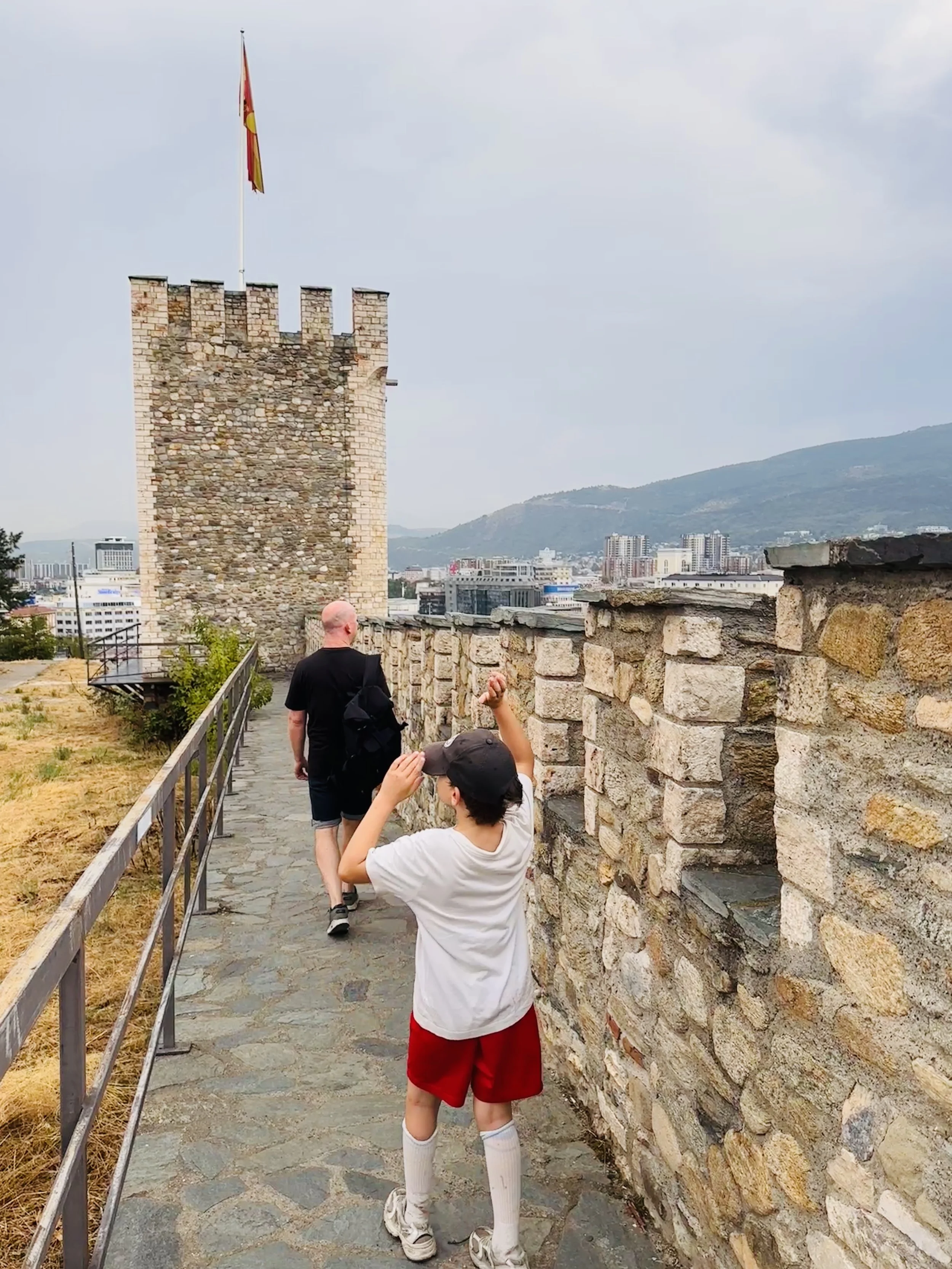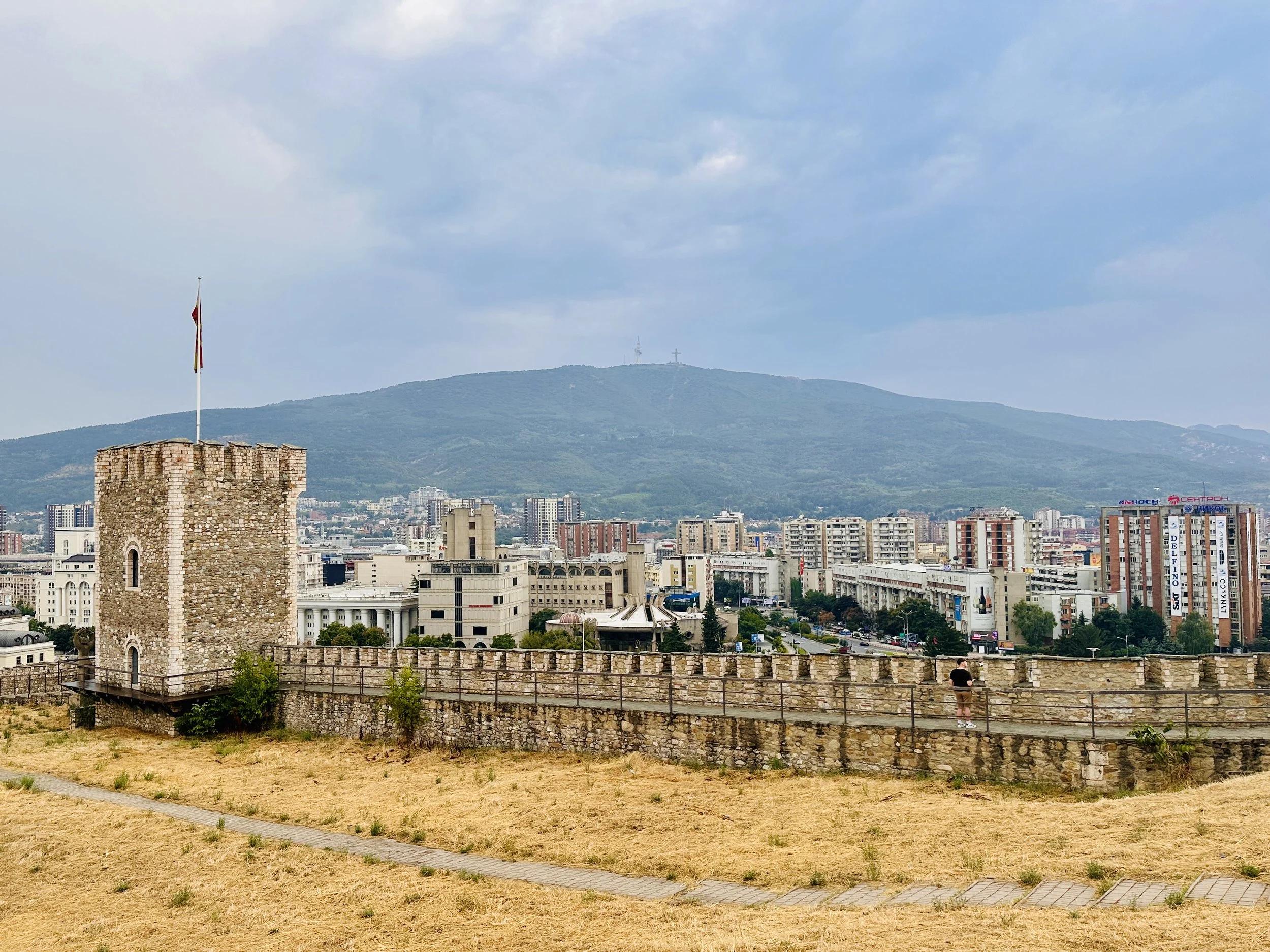Skopje, North Macedonia
On the 17th of August, we crossed the border to country number 9, North Macedonia. Another country we haven’t visited before. Yet again, we found a fairly central apartment in the center of the city and with 29 Euros per night, it actually was quite a bargain. Though actually finding it wasn’t as easy, as many identical looking skyscrapers in one block made the search quite tricky. A super friendly delivery driver guided us through the traffic (while picking up an order…) and through a maze of apartment blocks, until we found the right one. And he didn’t even accept the little tip we offered. Not all heroes wear capes! The apartment itself was really nice, even though the elevator of the apartment block didn’t age so well and made our kids use the stairs. But once we entered the flat, we had a really nice view over Skopje, which is by far the biggest city in North Macedonia and the home of its 526.000 inhabitants.
Let’s talk about the country first: North Macedonia, or the Republic of North Macedonia, as it is officially called, would actually be called Macedonia, if it wasn’t for the Greek. The country declared independence in 1991 as the Republic of Macedonia, but the Greek objected, claiming that its northern region is also called Macedonia, which was historically linked to Alexander the Great and Greek heritage. For around 30 years, this conflict blocked North Macedonia’s NATO and EU membership, until in 2018 the Prespa Agreement was signed with Greece, and the country agreed to change its name to Republic of North Macedonia. In return, Greece lifted its veto, allowing Nato accession in 2019 and helped pave the way for North Macedonia's EU membership. However, while the dispute with Greece was solved, the Bulgarians also weren’t too happy with the independence of North Macedonia either, as they claim that a lot of the North Macedonian history and identity is essentially theirs. They claim the same national heroes, a lot of the North Macedonian history, and the language is actually a Bulgarian dialect. Therefore, Bulgaria blocked North Macedonia's EU accession talks from 2020 to 2022, until in 2022 a compromise was found, under which North Macedonia agreed to some constitutional changes. All in all, not an easy path to become an EU member state.
Going further back in history, you see a lot of parallels to other countries in the region. North Macedonia was also under Ottoman rule from the late 14th century until the Balkan Wars in 1912. Macedonia was partitioned and today’s North Macedonia went to Serbia, the south went to Greece, and the east to Bulgaria. Under socialist Yugoslavia, the country and Skopje in particular, grew rapidly until a devastating earthquake in 1963 brought everything to a halt. The earthquake with epicenter very close to Skopje made 200.000 of its 300.000 inhabitants homeless and destroyed or damaged around 80% of the buildings. Skopje was rebuilt with international aid, which shaped the city’s current look. After the breakup of Yugoslavia, Macedonia claimed independence in 1991, and today, once the whole naming saga has been sorted, North Macedonia is oriented towards European integration.
Skopje presented an entirely new picture to us. Once we unpacked our car and parked it in a nearby parking garage, we had a stroll around the city and were pretty amazed by its massive, monumental looking buildings. On our way to the Macedonian Square, we temporarily thought we took a detour to Las Vegas, as many buildings looked like they'd been designed to look old and monumental. This was not necessarily because of the post-earthquake rebuild, but more because of “Skopje 2014” (https://en.wikipedia.org/wiki/Skopje_2014), a project launched by the North Macedonian government in 2009. The aim was to give the city a more European and historic look, thus attracting more tourism and emphasising its national identity. This resulted in dozens of neoclassical and baroque-style buildings and gigantic statues, such as the 22 meter tall “Warrior on a horse”, widely seen as Alexander the Great, who the Greek would claim to be theirs and who, to be fair, has very limited links to North Macedonia. None, actually. The project cost over 500 million (up to 700 million depending on the sources…) Euros and many locals would say that a lot of rubbish could have been picked up with that money. And indeed, what appears monumental from a distance, is already crumbling when you take a closer look, which makes you question this wannabe historic investment.
We, however, did enjoy our short walk through the Macedonian Square, the Stone Bridge and briefly into the outskirts of the Old Bazaar. After dinner we walked back to our apartment, knowing we had a second day to explore the city.
On our second day, the initial plan was to take the cable car to reach the top of Mount Vodno, but unfortunately, the cable car was closed for maintenance reasons. No problem though, as there was plenty left to be explored on our remaining day. We went to the “Mother Teresa house”, which is located on the spot where once the church was placed, in which she was baptized. Mother Theresa, or Anjezë Gonxhe Bojaxhiu, as her birth name was, was born in Skopje and lived here for the first 18 years of her life. She’s still a prominent figure in the city, as for example Skope’s University is named after her. We then walked along the Vardar river, looking at the above-mentioned muónumental buildings until we reached the Old Bazaar. The old bazaar reaches back to the 12th century, and once you get past the fake Balenciaga shirts, it actually becomes a beautiful maze of little streets with cafes and restaurants that invite you to wander around, having a Turkish Coffee or a small bite to eat. We stopped at the Aga Restaurant, which is very nondescript alongside one of the main roads of the bazaar. I actually saw some local workers there having lunch, which normally is the perfect sign for a local quality spot to eat. https://www.facebook.com/RestaurantAgaa/. They served us a great kebap! Since the sky was becoming increasingly darker, we decided to hit a supermarket for some essentials and do a little break in our apartment while a thunderstorm was rolling over Skopje.
In the afternoon, we went to the old fortress, which was first built in the 6th century CE, and is situated on the highest point of the city, overlooking Vardar River. The Ottomans expanded it between the 14th and 16th century and used it as a military stronghold. Also the fortress was severely damaged by the 1963 earthquake, but it’s been partially restored. It’s open to the public now and is a nice viewpoint over Skopje. Unfortunately, as in the rest of the city, you see a lot of rubbish laying around and you can’t get rid of the feeling that the hundreds of million Euro investment for “Skopje 2014” could have served a better, more sustainable purpose. We walked back through the old town, grabbed a small bite to eat and some milk for our breakfast and called it a night.
Tomorrow, on the 19th of August we will continue our ride to Lake Ohrid. An area I’ve been looking forward to since we started the journey, and where we will stay for almost a week, thus allowing us to slow down again…



















